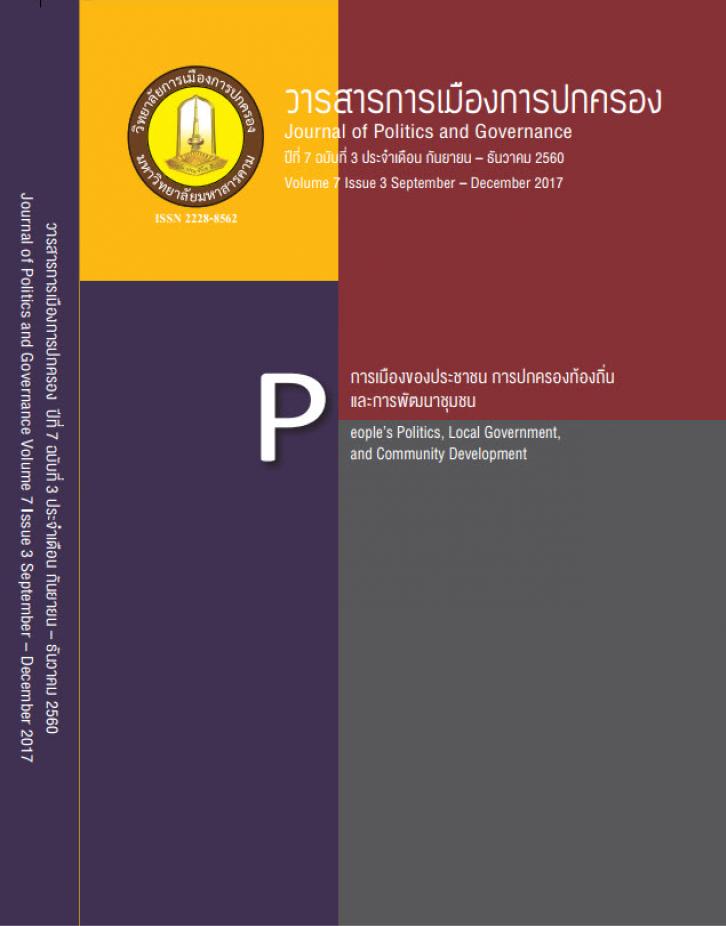The Evolution of Public Administration Science from the Administration - Political Dichotomy to the New Public Governance : Analysis Based on Accumulative Model
Main Article Content
Abstract
This paper aims to (1) describe development of public administration science from the administration-political dichotomy to the new public governance based on the accumulative model and (2) directed evolution of the public administration science in the future. The study suggests how the public administration science shapes certain educational views in the public administration science such as the change of the public role from the secondary role in the study group concerning the administration-political dichotomy to the primary role in the study group. It has been suggested that the evolution of public administration science requires development and study on other issues such as professional, ethics in public administration and organizational culture which are essential but have not been studied and developed in the study on public administration science. The development of public administration science should be carried out in collaboration with both national and international scholars and practitioner by relying on the combination of qualitative and quantitative research on public administration science in order to create strength in the study on public administration science until it becomes the strong awareness in the public administration science.
Article Details
References
สำนักคิดเศรษฐศาสตร์การเมืองแนววัฒนธรรมชุมชน. ใน หนังสือ 60 ปี ฉัตรทิพย์ นาถสุภา (ผาสุก พงษ์ไพจิตร บรรณาธิการ). ศูนย์เศรษฐศาสตร์การเมือง คณะเศรษฐศาสตร์ จุฬาลงกรณ์มหาวิทยาลัย. หน้า 31-109.
โชคชัย สุทธาเวศ. (2559). พัฒนาการแห่งศาสตร์ ความรู้พื้นฐานว่าด้วยทฤษฏีและการ
สร้างสรรค์ภูมิปัญญาไทย: ข้อพิจารณาสำหรับนักรัฐประศาสนศาสตร์. เอกสารประกอบการบรรยาย. คณะสังคมศาสตร์และมนุษยศาสตร์ มหาวิทยาลัยมหิดล.
Ansell, Chris & Gash, Alison. (2008). Collaborative Governance in Theory and Practice. Journal of Public Administration Research and Theory. 18(4). pp. 543-571.
Barzelay, Michael & Armajani, Babak J. (1992). Breaking through Bureaucracy. In Shafritz, Jay M. & Hyde, Albert C. (2007). Classics of Public Administration.
Wadsworth : Cengage Learning. pp. 519-540.
Bowornwathana, Bidhya. (2010). Minnowbrook IV in 2028 : From American Minnowbrook to Global Minnowbrook. Public Administration Review. 70. (1). pp. s64-s68.
Denhardt, Janet V., & Denhardt, Robert B. (2007). The New Public Service: Serving, Not Steering. New York and London : M.E. Sharpe.
Degeling, Pieter & Colebatch, Hal. (1993). Structure and action as constructs in the practice of public administration. In Hill, Michael. The Policy Process: A Reader. Hertfordshire : Harvester Wheatstheaf. pp. 349-361.
Frederickson, George. (1971). Toward a New Public Administration. In Shafritz, Jay M. & Hyde, Albert C. (2007). Classics of Public Administration. Wadsworth: Cengage Learning. pp. 296-307.
Frederickson, George H. & Smith. Kevin B. (2003). The Public Administration Theory Primer. Colorado : Westview Press.
Goodnow, Frank J. (1900). Politics and Administration. In Shafritz, Jay M. & Hyde, Albert C. (2007). Classics of Public Administration. Wadsworth : Cengage Learning. pp. 29-31.
Gulick, Luther. (1937). Notes on the Theory of Organization. In Shafritz, Jay M. & Hyde, Albert C. (2007). Classics of Public Administration. Wadsworth : Cengage Learning. pp. 81-89.
Gulrajani, Nilima & Moloney, Kim. (2012). Globalizing Public Administration : Today’s Research and Tomorrow’s Agenda. Public Administration Review. 72(1). pp. 78–86.
Henry, Nicholas. (2010). Public Administration and Public Affairs. 11th ed. New York : Longman.
Hood, Christopher. (1991). A Public Management for All Seasons?. Public Administration Review. 69(1). pp. 3–19.
Katz, Daniel & Kahn, Robert L. (1966). Organization and system concept. In Shafritz, Jay M. & Hyde, Albert C. (2007). Classics of Public Administration. Wadsworth : Cengage Learning. pp.89-198.
Lipsky, Michael. (1980). Street-Level Bureaucracy : The Critical Role of Street-Level Bureaucrats. In Shafritz, Jay M. & Hyde, Albert C. (2007). Classics of Public Administration. Wadsworth : Cengage Learning. pp. 412-419.
McGettigan, Timothy. (2011). Good Science : The Pursuit of Truth and the Evaluation of Reality. MD : Lexington Books. pp. 1-10.
Moe, Tery M. (1994). Integrating Politics and Organization : Positive Theory and Public Administration. Journal of Public Administration Research and Theory. 4(1). pp. 17-26.
Ott, J. Steven. (1989). Understanding Organizational Culture. In Shafritz, Jay M. & Hyde, Albert C. (2007). Classics of Public Administration. Wadsworth : Cengage Learning. pp. 490-496.
Osborne, Stephen P. (2010). Introduction the (New) Public Governance : a suitable case for treatment?. In Stephen P. eds. The New Public Governance: Emerging Perspectives on the Theory and Practice of Public Governance. London and New York : Routledge. pp. 1-16.
Pugh, Darrell L. (1989). Professionalism in Public Administration : Problems, Perspectives, and the Role of ASPA. Public Administration Review. 49(1). pp. 1-8.
Rohr, John A. (1978). Ethic for Bureaucrats: An Essay on Law and Values. In Shafritz, Jay M. & Hyde, Albert C. (2007). Classics of Public Administration. Wadsworth : Cengage Learning. pp. 361-369.
Rosenbloom, David H. (1983). Public Administrative Theory and the Separation of Power. In Shafritz, Jay M. & Hyde, Albert C. (2007). Classics of Public Administration. Wadsworth : Cengage Learning. pp. 442-453.
Shah, S. K., and Corley, K. G. (2006). Building better theory by bridging the quantitative-qualitative divide. Journal of Management Studies. 43(8). pp. 1821-1835.
Simon, Herbert A. (1946). The Proverbs of Administration. In Shafritz, Jay M. & Hyde, Albert C. (2007). Classics of Public Administration. Wadsworth: Cengage Learning. pp. 127-140.
Stivers, Camillam. (1990). Active Citizenship and Public Administration. In Wamsley, Gary L. Refunding Public Administration. California: Sage Publication. pp. 246-273.
Vinzant, Janet. (1993). Strange Bedfellows : Public Administration, Neutral Competence and Strong Parties. Administrative Theory & Praxis. 15(2). pp. 11-24.
Weber, Max. (1946). Bureaucracy. In Shafritz, Jay M. & Hyde, Albert C. (2007). Classics of Public Administration. Wadsworth: Cengage Learning. pp. 44-49.
Woodrow, Wilson. (1887). The study of administration. In Shafritx, Jay M. & Hyde, Albert C. (2007). Classic of Public Administration. Wadsworth: Cengage Learning. pp. 16-28.
Wright, Deil S. (1990). Federalism, Intergovernmental Relations, and Intergovernmental Management : Historical Reflections and Conceptual Comparisons. In Shafritz, Jay M. & Hyde, Albert C. (2007). Classics of Public Administration. Wadsworth: Cengage Learning. pp. 508-523.


